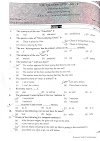First Law of Motion
A body continues to be in its initial condition of rest or a uniform motion in a straight line unless acted upon by an external force.
i.e. then,
First law of motion gives the qualitative definition of force.
First law gives the condition of equilibrium of the body.
Inertia: The property of a body by virtue of which it tries to be original state unless acted by an external force is called inertia.
First law tells about the inertia hence it is also called the law of inertia.
Mass is the measure of inertia.
Second Law of Motion
The rate of change of momentum is directly proportional to the force applied and acts in the direction of the force.
i.e.
When mass if constant
When velocity if constant
Second law of motion gives the quantitative definition of force.
Second law of motion is called the real law of motion.
Third law of motion
Every action has an equal and opposite reaction.
It gives the property of force that exists in pair.
Action and reaction occur in different bodies so they do not cancel out each other.
Linear momentum and Impulse
Momentum
The measure of the amount of motion contained in a body is called momentum.
It is a vector quantity.
It is conserved in absence of force.
Impulse
When a large amount of force is exerted in a small time, the effect is measured by impulse. the eg. hammering of the nail.
It is a vector quantity.
Area of the force-time graph gives impulse.
If is the average force imparting same impulse,
Apparent Weight and Motion in Lift
Apparent weight is a normal force transmitted through the ground. In short,
It is measured by spring balance.
m = Mass of Man
R = Apparent weight
a = Acceleration of elevator
g = Acceleration due to gravity
Elevator accelerating upward with constant acceleration
i.e weight of body increases
Elevator accelerating downward with constant acceleration
i.e weight of body decreases.
When ;
When ; Condition of free fall
When ; The person will rise from the ground.
Elevator is moving with constant velocity either up or down (a=0)
i.e. weight remains the same.
Note: For the whole system, the mass of the whole system should be taken i.e m should be replaced by “m + ”, where is the mass of the elevator. The apparent weight of the whole system is the tension on the rope-carrying elevator.
Rocket Propulsion
Based on Newton’s third law of motion.
= Thrust Force
So,
i.e.
where ,
= rate of combustion of fuel
v = velocity of exhausted fuel (or gas) w.r.t. rocket
m = instantaneous mass of rocket.
In problems considered in absence of gravity, put g= 0 in above formula for those circumstances.
Contact Force Between Two Bodies
Contact forces between three blocks
are mass of block A, B, C.
Force on A,
Force on B,
Force on C,
This formula can also be used to calculate tension at any point when number of masses are tied by string (or rope).
Mass – Pulley system
Free mass pulley system
Let us assume, the rope is massless and inextensible and the pulley is massless and frictionless. Hence, the pulley has a rope having the same tension. and be the masses of bodies.
Case I:
Acceleration,
Tension in string,
Reaction in pulley,
Case II:
Acceleration,
Tension in string,
Reaction in pulley,
Case II:
Acceleration,
Tension in string,
Reaction in pulley,
Mass-pulley system in an inclined plane
Acceleration,
Tension in rope,
Mass Spring System
- Spring in horizontal position
Spring in vertical position
Spring in series
For two springs with spring constant and in series:
Spring in parallel
For two springs with spring constant and in series:
Better You Know
- Newton's first law of motion and third law of motion can be derived from the second law of motion.
If and mass is constant,
It is the first law of motion.
During the collision of two bodies;
No external force, so the momentum should be conserved.
It is the third law of motion.
Hence, the second law of motion is called the real law of motion.
First law of motion gives concept of inertia and qualitative definition of force.
The second law of motion gives a quantitative definition of force.
The third law of motion gives the property of force to exist in pair.
The hunter is pushed back when he fires the bullet. It is due to the conservation of linear momentum. If the mass of the bullet is m, the man of the gun is m, and the speed of the bullet is v, the recoil speed is given by
The rocket works because of the law of conservation of linear momentum.
If a horizontal rod of length L is pulled by a horizontal force F, then tension at point P at a distance x from the next end (free end) is
i.e
When a body of mass m falls from height H and penetrates sand of depth d ,then
a. Retardation offered buy sand,
b. Time to penetrate sand of depth d,
c. Total resistance force offered by sand to body,
When a liquid jet of density d and cross-sectional area A strikes the vertical wall at
an angle with horizontal with velocity v, then
a. If it is bought at rest, Force on vertical wall
b.If water redounds elastically (i.e with the same velocity), Force on vertical wall
In case of the two-mass system over a pulley, acceleration of center of mass of
system is
A homogeneous rod of length L is acted upon by two forces and
applied on its ends and directed opposite to each other. The tension at a distance x from the end where smaller force is applied is
A false balance has equal arms. An object weighs when placed on one pan and when placed on other pan. The true weight of object is
A false balance has unequal arms. An object weighs when placed on one pan and when placed on other pan. The true weight of object is
A body is at top of the frictionless inclined plane. The necessary horizontal acceleration that is required
for free ball of body is
to keep body rest with respect to inclined plane is
A simple pendulum is attached to a floor of a carriage.
If the carriage is accelerating upward with uniform acceleration a,
If the carriage is decending with uniform acceleration a a,
If the carriage is moving forward with uniform acceleration a a,









0 Comments